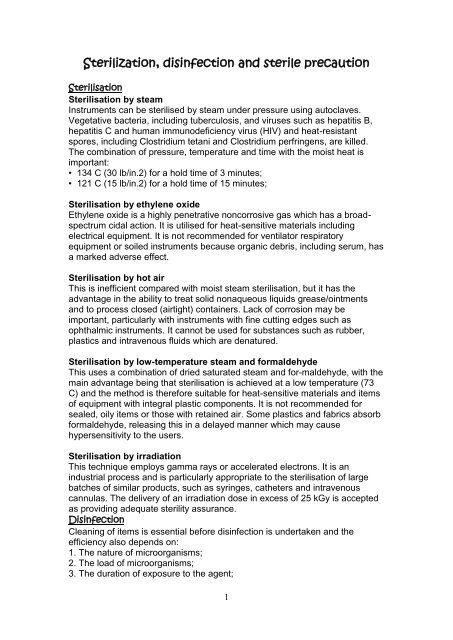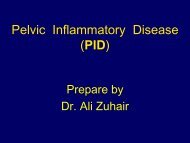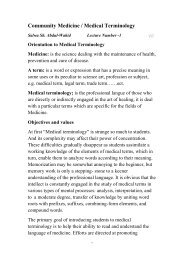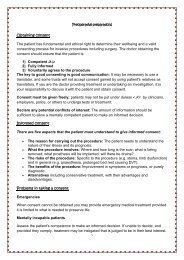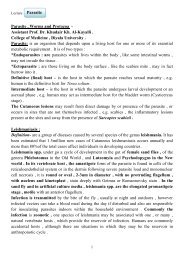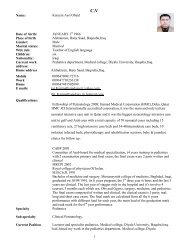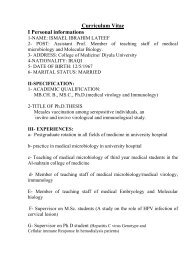Sterilization, disinfection and sterile precaution
Sterilization, disinfection and sterile precaution
Sterilization, disinfection and sterile precaution
Create successful ePaper yourself
Turn your PDF publications into a flip-book with our unique Google optimized e-Paper software.
<strong>Sterilization</strong>, <strong>disinfection</strong> <strong>and</strong> <strong>sterile</strong> <strong>precaution</strong><br />
Sterilisation<br />
Sterilisation by steam<br />
Instruments can be sterilised by steam under pressure using autoclaves.<br />
Vegetative bacteria, including tuberculosis, <strong>and</strong> viruses such as hepatitis B,<br />
hepatitis C <strong>and</strong> human immunodeficiency virus (HIV) <strong>and</strong> heat-resistant<br />
spores, including Clostridium tetani <strong>and</strong> Clostridium perfringens, are killed.<br />
The combination of pressure, temperature <strong>and</strong> time with the moist heat is<br />
important:<br />
• 134 C (30 lb/in.2) for a hold time of 3 minutes;<br />
• 121 C (15 lb/in.2) for a hold time of 15 minutes;<br />
Sterilisation by ethylene oxide<br />
Ethylene oxide is a highly penetrative noncorrosive gas which has a broadspectrum<br />
cidal action. It is utilised for heat-sensitive materials including<br />
electrical equipment. It is not recommended for ventilator respiratory<br />
equipment or soiled instruments because organic debris, including serum, has<br />
a marked adverse effect.<br />
Sterilisation by hot air<br />
This is inefficient compared with moist steam sterilisation, but it has the<br />
advantage in the ability to treat solid nonaqueous liquids grease/ointments<br />
<strong>and</strong> to process closed (airtight) containers. Lack of corrosion may be<br />
important, particularly with instruments with fine cutting edges such as<br />
ophthalmic instruments. It cannot be used for substances such as rubber,<br />
plastics <strong>and</strong> intravenous fluids which are denatured.<br />
Sterilisation by low-temperature steam <strong>and</strong> formaldehyde<br />
This uses a combination of dried saturated steam <strong>and</strong> formaldehyde, with the<br />
main advantage being that sterilisation is achieved at a low temperature (73<br />
C) <strong>and</strong> the method is therefore suitable for heat-sensitive materials <strong>and</strong> items<br />
of equipment with integral plastic components. It is not recommended for<br />
sealed, oily items or those with retained air. Some plastics <strong>and</strong> fabrics absorb<br />
formaldehyde, releasing this in a delayed manner which may cause<br />
hypersensitivity to the users.<br />
Sterilisation by irradiation<br />
This technique employs gamma rays or accelerated electrons. It is an<br />
industrial process <strong>and</strong> is particularly appropriate to the sterilisation of large<br />
batches of similar products, such as syringes, catheters <strong>and</strong> intravenous<br />
cannulas. The delivery of an irradiation dose in excess of 25 kGy is accepted<br />
as providing adequate sterility assurance.<br />
Disinfection<br />
Cleaning of items is essential before <strong>disinfection</strong> is undertaken <strong>and</strong> the<br />
efficiency also depends on:<br />
1. The nature of microorganisms;<br />
2. The load of microorganisms;<br />
3. The duration of exposure to the agent;<br />
1
4. The temperature.<br />
Disinfection with low-temperature steam<br />
Typical conditions include exposure to dry saturated steam at a temperature<br />
of 73 C for a period of 20 minutes at a pressure below atmospheric. This is a<br />
useful process for dealing with dirty returns from the operating theatre or<br />
clinics which may be contaminated with protein from bodily secretions <strong>and</strong><br />
microorganisms. Following this method of <strong>disinfection</strong> the instruments must<br />
be cleaned.<br />
Disinfection with boiling water<br />
This utilises soft water at 1000C at normal pressure for 5minutes. Instruments<br />
must be thoroughly cleaned before being utilised.<br />
Disinfection with formaldehyde<br />
Formaldehyde gas is a broad-spectrum antimicrobial agent. This process<br />
utilises a cabinet which is airtight <strong>and</strong> circulates gaseous formaldehyde up to<br />
50 C.<br />
Disinfection with glutaraldehyde<br />
A 2 per cent solution of glutataldehyde is effective against most bacterial<br />
viruses, including hepatitis B <strong>and</strong> C <strong>and</strong> HIV, <strong>and</strong> is particularly useful for the<br />
decontamination of flexible endoscopes.<br />
• Thorough cleansing is essential.<br />
• The degree of decontamination is proportional to the time of immersion.<br />
• It is a toxic substance <strong>and</strong> causes irritant, allergic reactions to the staff,<br />
particularly skin reactions, which limits its use.<br />
Sterile <strong>precaution</strong> in the theatre<br />
Bacterial infection<br />
The presence of an infected skin lesion, such as a boil, paronychia or<br />
carbuncle, known carrier state, particularly in the nares <strong>and</strong> the presence of<br />
an acute bacterial infection, particularly an upper respiratory tract infection,<br />
must lead to the exclusion of such a person from the team.<br />
Showering<br />
Showering is preferable to bathing <strong>and</strong> the utilisation of a 4 per cent<br />
chlorhexidine gluconate soap by the surgical team is of benefit before the start<br />
of an operating list, <strong>and</strong> has been recommended for the operating surgeon<br />
between cases when the procedure is long.<br />
Clothing <strong>and</strong> gowning<br />
Desquamation principally occurs from the lower half of the body <strong>and</strong> the<br />
changing from normal clothes to clean linen reduces the bacterial count;<br />
Caps are usually worn, although the amount of pathogenic bacteria dispersed<br />
is unlikely to be of any significance in general surgery, but may again be<br />
significant in implant surgery.<br />
Masks<br />
The oropharynx is a low-level source of bacteria (36 bacteria per 100 words<br />
spoken are generated), the number of bacteria that settle on culture plates is<br />
not affected by wearing a mask <strong>and</strong> several studies exist to show that the<br />
wearing of masks in general surgery does not affect the wound infection rate,<br />
although the wearing of masks in implant surgery is appropriate as their use<br />
2
has been shown to decrease the number of bacteria detected at the operating<br />
site.<br />
• Their use is indicated in implant <strong>and</strong> orthopaedic surgery.<br />
• They offer protection to the wearer.<br />
• Reduction of speech at the operating table is important.<br />
Gloving<br />
Although gloving or double gloving is widely practised there is little evidence<br />
that wound infection is related to glove puncture. This would suggest that<br />
<strong>disinfection</strong> of the h<strong>and</strong>s is important in keeping the incidences of wound<br />
infection low.<br />
Scrubbing up<br />
Brushes should only be used for cleaning finger nails. A scrub-up time of 3—5<br />
minutes with chlorhexidine soap or povidone iodine soap is utilised; the former<br />
is a broad-spectrum rapidly active agent with persistent activity, whereas the<br />
latter has a relatively short duration. The technique should include thorough<br />
washing of the h<strong>and</strong>s to the elbows, with removal of the soap in the direction<br />
h<strong>and</strong> to elbow.<br />
Adequate drying is again essential, the preferred technique using paper<br />
towels in the direction h<strong>and</strong> to elbow. Jewellery should.be removed<br />
The operation<br />
Preoperative preparation of patient<br />
Factors to be taken into account include the following.<br />
• Preoperative showering with hexachlorophane is widely used in Sweden<br />
but not elsewhere; subjects shower twice on the day before <strong>and</strong> once on the<br />
day of surgery. This has been shown to reduce the incidence of wound<br />
infection.<br />
• A short preoperative hospital stay is important; this reduces both the<br />
presence of pathogenic bacteria on the skin <strong>and</strong> the incidence of nasal carrier<br />
state (Staphylococcus aureus) among patients on the ward.<br />
• Shaving — the trauma of shaving undoubtedly results in lacerations to the<br />
skin, which can increase infection rate; it is preferable to use either clippers<br />
or, ideally, depilation cream but the latter is expensive..<br />
Skin preparation<br />
Before arrival in theatres the skin of the operation site should be washed with<br />
detergent-impregnated soap. This cleans the skin. In the operating theatre<br />
antiseptic solutions, usually of an alcohol-based detergent such as<br />
chlorhexidine or povidone iodine, give optimal <strong>disinfection</strong>. The solution<br />
should be allowed to dry to maximise the reduction of bacteria, <strong>and</strong> pools of<br />
residual alcoholic solution, such as occur at the umbilicus or in the perineum,<br />
must be dried off completely, otherwise there is a danger of burning with the<br />
use of diathermy. The vagina <strong>and</strong> perineum should be cleaned with aqueous<br />
chlorhexidine <strong>and</strong> cetrimide solution.<br />
High-risk infection procedures<br />
Again, there should be careful protocols for the h<strong>and</strong>ling of blood <strong>and</strong> body<br />
fluids in order to reduce the risk of auto-infection <strong>and</strong> cross-infection, for<br />
hepatitis B <strong>and</strong> C viruses, HIV <strong>and</strong> cytomegalovirus; such <strong>precaution</strong>s are of<br />
3
particular importance in patients who have pre-existing infection or who are<br />
immunosuppressed.<br />
The procedure<br />
High st<strong>and</strong>ards of asepsis in the operating theatre dem<strong>and</strong> clear protocols or<br />
guidelines with regard to the conduct of surgery, <strong>and</strong> must be monitored by<br />
the theatre manager. The proper performance of surgery ensures safety for<br />
the patient, surgeon <strong>and</strong> staff.<br />
General measures include:<br />
• Education of staff so that they are fully aware that there is a full vaccination<br />
programme for hepatitis B;<br />
• The availability of advice for staff in the event of injury.<br />
practical measures include:<br />
• identifying high-risk patients on the operating list;<br />
• Reduction of the number of staff in the theatres to cover essential roles only;<br />
• Removal of all extr equipment from the theatre;<br />
• Staff should avoid contact with contaminated body fluids, especially blood,<br />
<strong>and</strong> in this respect abrasions should be covered. If the member suffers from<br />
eczema, he or she should be excluded from the theatres <strong>and</strong> if contamination<br />
does occur rapid washing should be undertaken.<br />
• When h<strong>and</strong>ling potentially contaminated blood or body fluids, scrub staff<br />
should use nonpermeable gowns <strong>and</strong> masks with eye protection <strong>and</strong> should<br />
double glove.Circulating personnel should use plastic aprons <strong>and</strong> wear<br />
gloves.<br />
• Spills should be dealt with by staff wearing gloves <strong>and</strong> using absorbent<br />
disposable clothes; hypochlorite 1 per cent solution may be applied to blood<br />
spilt on the floor.<br />
• Particular care should be taken with the h<strong>and</strong>ling of sharps, which should<br />
always be kept in receivers.<br />
• Swabs should be counted but not left exposed, as for routine operations on<br />
a spike rack, they should be placed in deep ‘swab pockets’ on plastic racks.<br />
• Disposable equipment should be placed in yellow bags at the earliest<br />
possible time, then sealed <strong>and</strong> double bagged with a hazard label attached.<br />
• Instruments must be h<strong>and</strong>led in such a way as to avoid injury to the patient<br />
<strong>and</strong> staff..<br />
• Instruments should not be left on drapes where they can directly injure the<br />
patient or damage the drapes, breaching asepsis.<br />
• Instruments should be well maintained so that no body fluid remains on the<br />
instruments after washing.<br />
4


